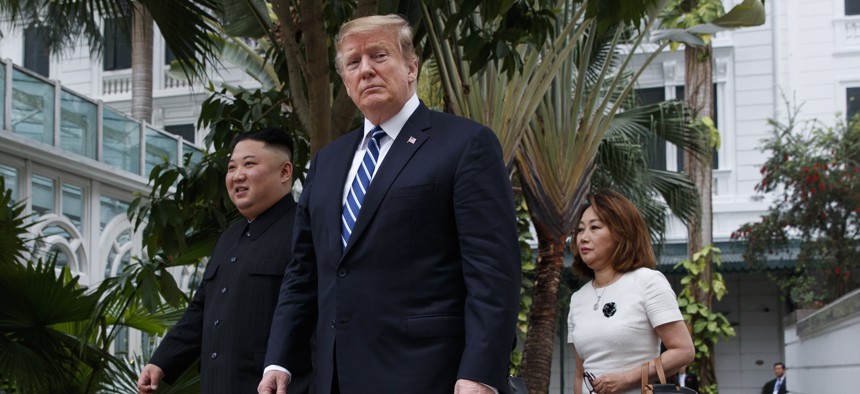
President Donald Trump and North Korean leader Kim Jong Un take a walk at the Sofitel Legend Metropole Hanoi hotel, Thursday, Feb. 28, 2019, in Hanoi. AP Photo/Evan Vucci
How the White House Is Spinning the North Korea Summit Collapse
The administration no longer thinks Trump alone can reach a deal with Kim Jong Un.
It’s now known rather famously, in Donald Trump’s Twitter feed at least, as the “walk”—the president cutting short his summit in Vietnam with Kim Jong Un because, per a wisdom that fast took root back in Washington, no nuclear deal was better than a bad one.
Since the standoff in late February, however, the reasons Trump walked and where he’s headed on North Korea have remained obscure. In a classified briefing last week to the Senate Foreign Relations Committee, the president’s special representative for North Korea, Stephen Biegun, dropped a number of hints—including, according to one senator who was in the room, that the administration is now placing hope for a breakthrough in the lower-level negotiations it once ridiculed. Biegun himself has since argued publicly that even though the summit didn’t yield a deal, Trump’s personal diplomacy with Kim may yet compel the North Korean leader to direct those negotiating on his behalf to reach one.
A year ago, when Trump became the first U.S. president to agree to a meeting with his North Korean counterpart, a senior administration official declared that the history of unsuccessful working-level talks to denuclearize North Korea during the Clinton, Bush, and Obama administrations “speaks for itself.” Under Trump, who cites his “great relationship” with Kim as the primary reason he will succeed where his predecessors failed, the approach has been to set a date and location for the leaders to get together and then have their deputies scramble to deliver results, rather than the other way around.
Critics have argued that in placing such emphasis on his personal dealings with Kim, Trump has undercut his advisers. After the second summit ended without a deal, however, the Trump administration is pointing to a silver lining: The summit’s collapse could paradoxically empower the leaders’ diplomats and technocrats.
Ahead of their meeting in Hanoi, “it just seemed pretty clear to [Biegun] that Kim was playing the waiting game for the one-on-one” with Trump, the Connecticut Democrat Chris Murphy told me. Biegun’s argument is that walking away “sets the conditions for serious negotiations [by lower-level officials] that couldn’t happen until Kim realized he couldn’t pull one over on Trump.”
Asked for comment on these and other characterizations of Biegun’s briefing provided to The Atlantic by senators who met with him, a State Department spokesperson declined to “comment on remarks made in a classified setting.”
At a conference in Washington, D.C., on Monday, Biegun defended Trump’s approach of engaging directly with Kim. “We have tried for 25 years to percolate positions up from the working level to the leadership level, with no success,” he said. Kim is the only “one who can truly create the space for my counterparts sitting across the table from me to be flexible, to be agile, to be creative, to find solutions to these issues.”
Nevertheless, a senior State Department official conceded that Kim has yet to grant his subordinates space to negotiate. “We need the North Korean negotiators to have much more latitude than they did in the run-up to the summit on denuclearization,” the official said in a briefing with reporters last week, while stressing that Trump’s meetings with Kim were an indispensable feature rather than a bug in that effort.
Ron Johnson, a Republican from Wisconsin who also attended Biegun’s briefing, told me he still understands the leader-to-leader talks to be a critical component of the administration’s approach.
As Johnson sees it, Kim wrongly assumed that he could wring economic concessions from Trump for little in return, as North Korea’s leaders have done with previous American presidents. “Obviously, he came [to Vietnam] thinking he could talk Trump into a bad deal, and good thing he wasn’t able to,” the senator said.
But Murphy left Biegun’s briefing with the sense that both leaders—in spending the months following their first summit in Singapore pinning progressexclusively on their personal abilities to make a deal with each other—had made strategic mistakes ahead of Hanoi.
Kim’s was his “refusal to engage in any serious pre-negotiations” through his subordinates, Murphy told me. “Biegun was knocking at the door, day after day, and for the most part, nobody was answering. Kim seemed to make the calculation that he had buttered Trump up so sufficiently to be more likely to get what he wanted from Trump directly than through intermediaries.”
Biegun, who was appointed last August, managed to get meetings with his North Korean counterpart only in January, just as the second Trump-Kim meeting was announced. The State Department has acknowledged that Biegun’s talks with North Korean officials in the weeks before the summit didn’t make much headway on the core issue of denuclearization. Secretary of State Mike Pompeo was reportedly snubbed by his North Korean counterpart even as Trump made his way to Vietnam on Air Force One.
Trump’s blunder, in Murphy’s telling, was that he “thought that by sheer force of personality in Hanoi, he could get Kim to agree to a comprehensive deal, which was never going to be possible, and so instead of immediately setting the table with some confidence-building measures, he went for the whole enchilada and lost badly.”
“I think Kim walked in thinking that his love letters [to Trump] were going to get sanctions released for something much less than full denuclearization,” Murphy said. “Trump thought that these love letters meant he was going to get full denuclearization for sanctions relief. I think it was pretty clear pretty quickly that neither of those things was going to happen.”
In his remarks on Monday, Biegun credited the leaders’ exchange of letters with breaking an impasse in working-level negotiations in late December. But he also confirmed Murphy’s distillation of the basic dispute in Hanoi. Kim, Biegun explained, offered to dismantle only a portion of his nuclear program at the country’s main Yongbyon facility in exchange for the United States lifting the bulk of international sanctions. (U.S. negotiators had dismissed this idea as unworkable in meetings with their North Korean counterparts in the weeks before the summit.) Trump’s counteroffer was for Kim to “go big” and commit to eliminating his entire weapons-of-mass-destruction program, including nuclear, chemical, and biological arms. In exchange, the United States would help transform North Korea’s economy and relationship with the United States. Each side balked at the other’s proposal.
Many experts had interpreted a speech Biegun had delivered at Stanford ahead of the Vietnam summit as a sign that the administration had recognized the folly of pressuring North Korea into swiftly giving up all its nuclear weapons—and was instead pivoting to a more protracted process of phased peace building, political normalization, sanctions relief, and rollback of the North Korean nuclear program. But on Monday, Biegun stated that the United States would not lift sanctions “until North Korea completes the process of denuclearization,” echoing an overlooked line from his Stanford speech. “We are not going to do denuclearization incrementally.”
What the United States and North Korea are engaged in, Biegun argued, “is much bigger than denuclearization” and of a different nature than what he characterized as Barack Obama’s narrow nuclear deal with Iran. That’s why at Stanford he sketched a vision of North Korea shipping out its last nuclear weapons, the United States removing sanctions and opening an embassy in Pyongyang, and the two sides signing a peace treaty at the same time.
The much-reported details of which nuclear facilities North Korea was willing to trade for which sanctions in Vietnam, in other words, are something of a red herring. What mattered is that the North Koreans viewed a partial nuclear agreement as the only way to move forward, and the Americans considered such a deal the surest way to move backward.
“What North Korea has done consistently in the past is promised to denuclearize and then, by the way, not do it, to get economic benefits, which provide their economy a lifeline … and then allow them to go back to the nuclear program,” National Security Adviser John Bolton said after Hanoi.
Biegun came across in his briefing as “pretty confident that [the administration’s] basic strategy here is the only one that’ll actually work,” said Johnson. “Nobody can predict what Kim Jong Un will do, but I didn’t sense any concern or panic … He fully realizes how difficult this is.”
Jeff Merkley, a Democrat from Oregon, said his sense from the briefing was that the administration’s strategy is “we’re going to keep pressing economic sanctions, we think it’s having a toll on them, and they’ll eventually come around” to “make this grand deal,” despite signs that North Korea is finding ways to bypass sanctions, and China, the North’s principal trading partner, isn’t enforcing them as strictly as it once was.
The administration is characterizing Trump’s walk in Hanoi as a message to North Korea “that partial [nuclear] dismantlement is just not an acceptable place to end up,” he told me, and North Korea, with its renewed work at nuclear-weapons-related sites in recent weeks, is sending its own message that “we’re going to keep going forward unless you adopt the partial vision that we have of getting rid of these sanctions in exchange for [a] first step” on denuclearization. Each side, he noted, is trying to convey to the other “that we’re really serious: Your position is not acceptable.”
As Victor Cha, who negotiated with the North Koreans during the George W. Bush administration, recently noted, each side appears to have learned the same lesson in Hanoi: “Pressure works.” (“The pressure’s not on us,” Biegun declared this week, even as he admitted that “we don’t know” what North Korea’s revived activity at nuclear sites signifies.)
The infinite-loop debate about whether to go big or go small in their talks, Cha added, harks “back to the sort of negotiations that we have been in for the past 25 years.”
The “two leaders have learned that love does not conquer all,” Alexander Vershbow, the former U.S. ambassador to South Korea, said in his conversation with Cha.
In holding out for a Big Deal with North Korea, Trump is banking on the country’s leaders deciding to do what his own intelligence officials (and top advisers, such as Bolton) say is highly unlikely: fully give up a nuclear program they have invested heavily in for decades and come to consider essential for the survival of their regime. What the United States is now angling for, a year into its diplomacy with North Korea, is to have it all: breakthroughs in negotiations at both the leader and lower levels, an indefinite and unrelenting pressure campaign that produces a swift grand bargain on peace and denuclearization.
Such a deal would be an utterly unprecedented accomplishment if Trump pulls it off. But if the dim history of nuclear negotiations with North Korea isn’t exactly repeating itself in the wake of the Vietnam summit, it’s starting to rhyme.




